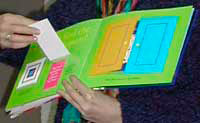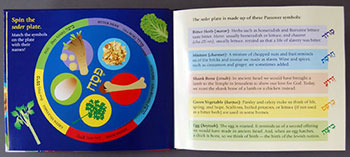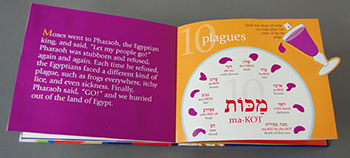
The Passover Seder
(Published by Cartwheel Books, Scholastic, Inc., 2003. Out of print.)
Association of Jewish Libraries 2003 Notable Book for Younger Readers
“Besides being fun, this book has a uniquely personal feel that reaches right to the heart and soul of its readers.” —Hanna Geshelin, The Jewish Journal of Greater Los Angeles
 Publishers Weekly
Publishers Weekly
Clever paper engineering turns The Passover Seder by Emily
Sper into interactive educational fun. Kids can rotate a seder plate
laden with bitter herb, charoset, etc., to match each item with its
English and Hebrew names (transliteration is provided); pull a tab to
“spill” a drop of wine for each of the 10 plagues; and look
behind flaps to find the afikoman. The text outlines the steps of a
seder and adds bonus facts (e.g., why the Red Sea doesn't always look
blue). Bold yet polished graphics ensure a strong visual appeal.
 www.childrenslit.com
www.childrenslit.com
This well-written book mixes a timeless story with lift-the-flap
activities that give young children a literal feeling about the Passover
holiday. Pages let children touch bumpy matzoh, scratchy “karpas”
(herb) and the satiny pillow that cushions a Seder chair. They can “break”
a matzoh, spin a Seder plate to match symbols with their names (in English
and Hebrew), and "spill" a drop of wine for each of the 10
plagues. These activities support, rather than detract from, thesimple
but dramatic text such as, “Moses raised his staff and the Red
Sea split, forming two walls of water! We walked on the bottom of the
sea until we reached the other side. We were free!” This book
would be a good read-aloud all year round, to reinforce the history
of the Jews, and to remind children of the celebration that will come
again each spring. 2003, Scholastic, Ages 2 to 6, $9.99. Reviewer:
Donna Freedman
 The Jewish Journal of Greater Los Angeles
The Jewish Journal of Greater Los Angeles
Children ages 3-7 will enjoy Emily Sper’s “The Passover
Seder: Touch, Turn, Open and Learn!” (Cartwheel Books, 2003, $9.99).
The seder plate turns, the Haggadah opens “back to front”
like a real Hebrew book, the matzah cover lifts and the afikomen can
be “broken.” The use of Hebrew, in Hebrew type and transliterated,
gives the beginning Hebrew student a challenge. The Hebrew pronunciation
key includes suggestions for saying a proper Hebrew “ch”
sound, and the author explains that there are different ways to pronounce
the same words. Extra details that young sedergoers might not know abound,
such as the fact that matzah is made in less than 18 minutes. Sper writes
as though she and the reader are recalling an Exodus in which they participated:
“We walked on the bottom of the sea until we reached the other
side. We were free! We were safe!” Besides being fun, this book
has a uniquely personal feel that reaches right to the heart and soul
of its readers. —Hanna Geshelin
Forward
Emily Sper’s “The Passover Seder” (Scholastic) lets
the young Seder guest “touch, turn, open, and learn” about
what is for many families the ritual event of the year. Sper’s
interactive book has moving cut-outs on every page that take the reader
through the Seder, letting your child “break” the middle
matzo, “spill” a drop of wine for each of the 10 plagues
and “open” the door for Elijah. Bilingual bonus: The book
includes the Hebrew words for key Seder terms, along with a transliteration
and an English translation. —Aliza
Phillips
Winston-Salem Journal
Surprisingly, this seemingly light-fare, inexpensive book is
loaded with pertinent information presented in an engaging format. After
a brief introduction, which includes a Hebrew pronunciation guide, page
after page shares key aspects of the seder, using an interactive format
in which readers manipulate pieces of the illustration to better understand
the textual explanation. Sturdy paper stock offers the opportunity to
“break” matzah, to turn the seder plate and to move Moses
through the separated Red Sea.Symbols and the underlying story are clearly
explained on an elementary level with the accompanying colorful illustrations
obvious in their intent. Even though the material is presented in a
nonfiction format rather than through a distinct storyline, young readers
and groups will be drawn to finish this inviting book completely, in
one sitting.
The Associated Press
In “The Passover Seder” (Scholastic, $9.99, ages 3-7), children
can spin a paper plate to match pictures of the symbolic shank bone
and bitter herb to their Hebrew names, and they can pretend to drop
some wine to mark each of the 10 plagues with the help of a tipsy glass.
Unlike many children’s Passover books that are simplified versions
of the Haggadah, the story of the holiday that also acts as a step-by-step
seder guide, Emily Sper’s book is a precursor to the family gathering,
explaining the customs that children will soon see. —Samantha
Critchell
Scholastic Press Release
From Emily Sper, the innovative creator of Hanukkah: A
Counting Book in English, Hebrew, and Yiddish comes The Passover
Seder (Cartwheel Books/Scholastic; February 2003; $9.99; Ages 3-7).The
Passover Seder offers a unique tool for familiarizing young children
with the background and symbols of this remarkable custom. Along with
a simple retelling of the Passover story, this novelty book takes readers
through a hands-on seder experience. Young readers can open a Hagaddah;
turn a seder plate to match symbolic foods with their names;
lift the napkin and “break” the middle matzah; touch matzah, parsley, and a pillow while reading the Four
Questions; pour drops of wine to symbolize the ten plagues; help the
Jews cross the Red Sea; search for the hidden afikomen; and open the
door to welcome Elijah the Prophet. With this fun and engaging book,
children everywhere will be able to have hands on experience with the
ritual of the Passover seder.